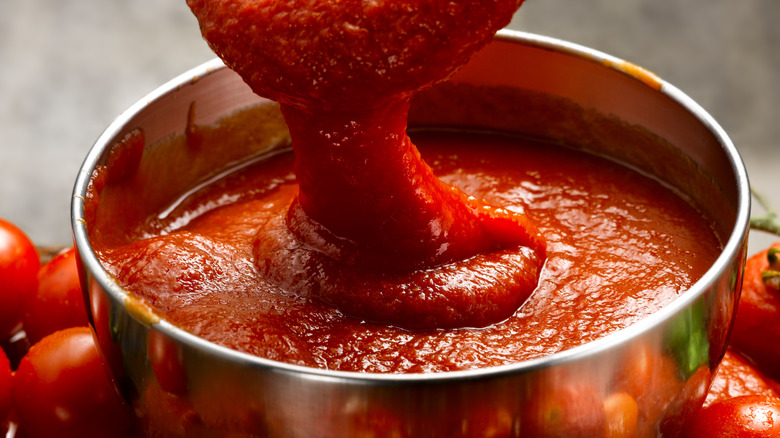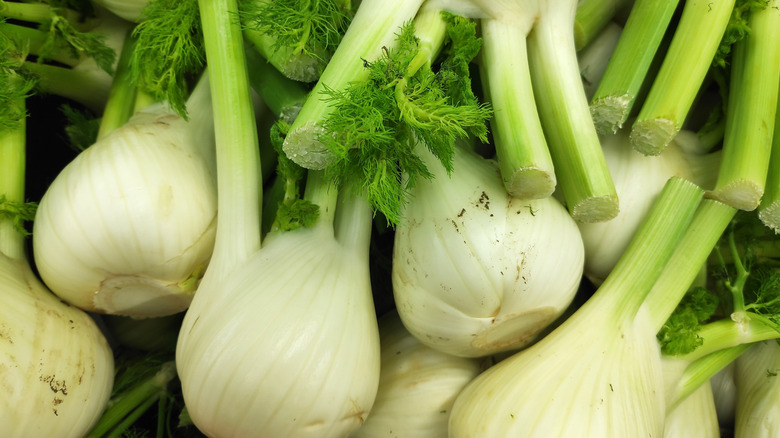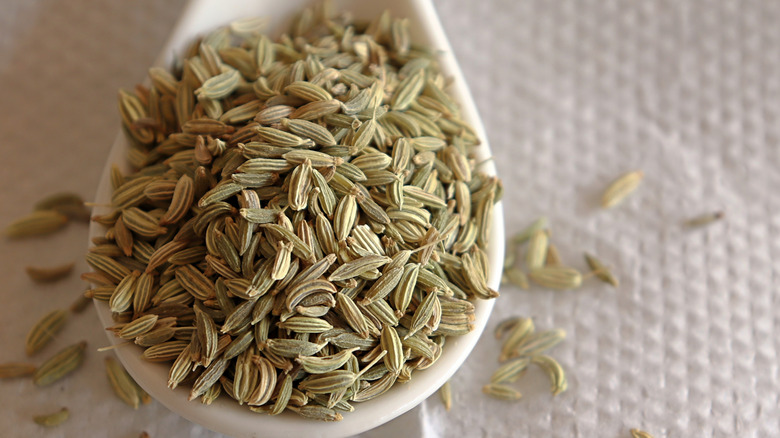The Underrated Spice And Meat Combo That Belongs In Tomato Sauce
Fennel isn't the first spice most people think to add to tomato sauce, but it has a way of transforming the flavor from simple to layered; you can do a whole spaghetti sauce makeover, if you will. Its gentle sweetness and subtle anise-like aroma balance the acidity of the tomatoes while adding a depth that lingers in the background. According to Anthony Paone, executive chef at Campanella in Sebastopol, California, "Fennel would add more sweetness, but alone would be a strange addition to me."
Paone explains that fennel seed is usually the better choice for sauce. "Probably the seed," he says, when asked if fresh fennel would work. Whole seeds can be toasted in olive oil to release their fragrance before adding tomatoes, while ground fennel offers a softer, more integrated flavor. The goal, Paone emphasizes, is balance — enough to give the sauce a fragrant lift without overpowering the other ingredients. Used this way, fennel becomes part of the sauce's foundation, enhancing its complexity without stealing the spotlight.
How fennel pairs with meat in Italian and creative dishes
In Italian cooking, fennel has a long-standing role in dishes where it's paired with meat, particularly pork. The spice's sweetness plays against the richness of the meat, creating a sauce that feels balanced instead of heavy. Paone says this is where fennel makes the most sense. "As someone who is cuckoo for fennel and its seeds, truly, I am at a loss unless some pork braised element to the sauce was included, like sweet Italian sausages." His opinion is right in line with the knowledge he shared of traditional Italian dishes that combine tomato sauce with fennel, to which he immediately named Italian sausage braised in tomato sauce.
This classic pairing works because the fennel-flavored sausage releases its essence into the tomato base as it cooks, infusing the sauce with aromatic depth. Beyond tradition, Paone also sees potential for fennel in less expected places. "In a nontraditional seafood Bolognese, I could see fennel playing a part," he says. "Or maybe added sparingly to a puttanesca." In seafood-based sauces, the sweetness of fennel can echo the natural sweetness of shellfish; while in a puttanesca, it can subtly offset the briny olives and capers. These applications show that fennel doesn't have to be reserved for sausage; it can be woven into other styles of tomato sauce when used with restraint and intention. It might even be a good idea to upgrade jarred pasta sauce for those who don't make their sauces from scratch.
Tips for using fennel in tomato sauce without it becoming overpowering
The main thing to keep in mind when working fennel into tomato sauce is moderation. Starting with 1 teaspoon of fennel seed for a pot serving four to six people will let the flavor complement rather than dominate the sauce. Toasting the seeds briefly in olive oil before adding tomatoes and meat will deepen their aroma. For a milder effect, grind the seeds first so they disperse evenly, infusing the sauce without leaving whole seeds behind. Adding fennel in general gives you a nice aromatic base, but you've got to go about it the right way so you don't ruin the dish.
Supporting ingredients like garlic, onion, and crushed red pepper can mellow out fennel's sweetness; preventing the sauce from feeling like one candy-sweet note. When experimenting, the takeaway is that fennel is a flavor amplifier in that it makes other components taste fuller and more well-rounded. Used thoughtfully, fennel turns a standard tomato sauce into something way more complex and delicious than you expected.


